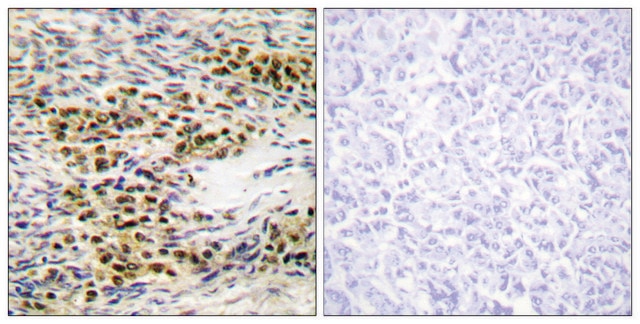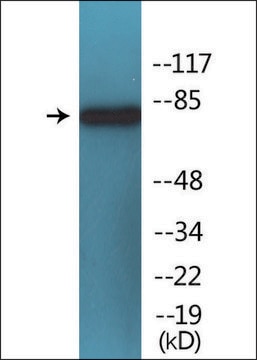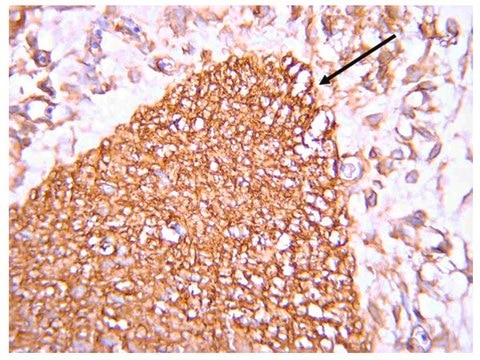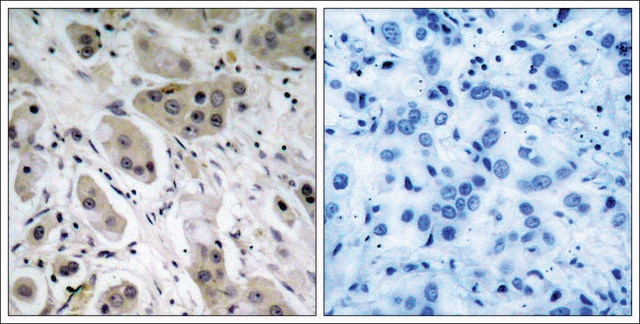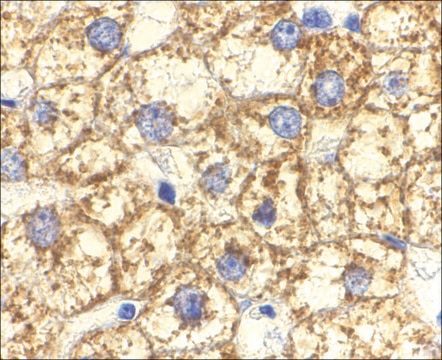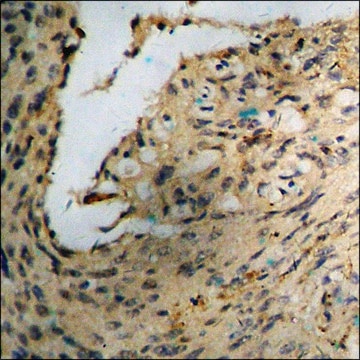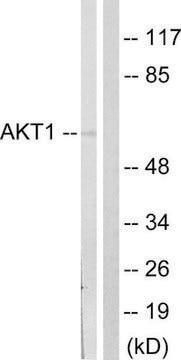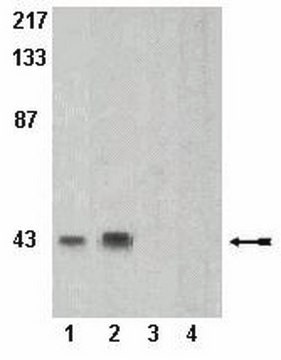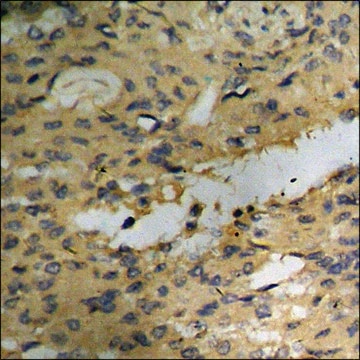07-789
Anti-phospho-AKT (Thr34) Antibody
Upstate®, from rabbit
Synonym(s):
Akt1, PKB, PRKBA, RAC, RAC-ALPHA
Sign Into View Organizational & Contract Pricing
All Photos(1)
About This Item
UNSPSC Code:
12352203
eCl@ss:
32160702
NACRES:
NA.41
Recommended Products
biological source
rabbit
Quality Level
antibody form
affinity purified immunoglobulin
antibody product type
primary antibodies
clone
polyclonal
purified by
affinity chromatography
species reactivity
human
manufacturer/tradename
Upstate®
technique(s)
western blot: suitable
isotype
IgG
NCBI accession no.
UniProt accession no.
shipped in
dry ice
target post-translational modification
phosphorylation (pThr34)
Gene Information
human ... AKT1(207)
Specificity
Predicted to cross react with Mouse and Rat due to high sequence homology, but have not been tested.
Recognizes phospho-AKT (Thr34)
Immunogen
KLH conjugated peptide corresponding to amino acid region encompassing the human phospho-AKT (Thr34); Sequence highly conserved in mouse and rat.
Application
Anti-phospho-AKT (Thr34) Antibody detects level of phospho-AKT (Thr34) & has been published & validated for use in WB.
Research Category
Signaling
Signaling
Research Sub Category
PI3K, Akt, & mTOR Signaling
General Post-translation Modification
PI3K, Akt, & mTOR Signaling
General Post-translation Modification
Quality
Routinely evaluated by immunoblot.
Target description
60 kDa
Physical form
100 μL of epitope specific affinity purified rabbit polyclonal IgG in 50% affinity storage buffer (PBS containing 1.0 mg/mL BSA and 0.05% sodium azide) and 50% glycerol.
ImmunoAffinity Purified
Storage and Stability
Stable for 2 years at -20°C from date of shipment. Upon first thaw, and prior to removing the cap, centrifuge the vial and gently mix the solution. Aliquot into microcentrifuge tubes and store at -20°C. Avoid repeated freeze/thaw cycles, which may damage IgG and affect product performance. Note: Variability in freezer temperatures below -20°C may cause glycerol-containing solutions to become frozen during storage.
Legal Information
UPSTATE is a registered trademark of Merck KGaA, Darmstadt, Germany
Disclaimer
Unless otherwise stated in our catalog or other company documentation accompanying the product(s), our products are intended for research use only and are not to be used for any other purpose, which includes but is not limited to, unauthorized commercial uses, in vitro diagnostic uses, ex vivo or in vivo therapeutic uses or any type of consumption or application to humans or animals.
Not finding the right product?
Try our Product Selector Tool.
wgk_germany
WGK 2
Certificates of Analysis (COA)
Search for Certificates of Analysis (COA) by entering the products Lot/Batch Number. Lot and Batch Numbers can be found on a product’s label following the words ‘Lot’ or ‘Batch’.
Already Own This Product?
Find documentation for the products that you have recently purchased in the Document Library.
Cisplatin activates Akt in small cell lung cancer cells and attenuates apoptosis by survivin upregulation
Belyanskaya, Larisa L, et al
International Journal of Cancer. Journal International Du Cancer, 117, 755-763 (2005)
PKB/Akt: connecting phosphoinositide 3-kinase to cell survival and beyond.
Marte, B M and Downward, J
Trends in Biochemical Sciences, 22, 355-358 (1997)
Virginia Actis Dato et al.
Cells, 9(1) (2020-01-16)
Abstract: The cardiovascular disease (CVD) frequently developed during metabolic syndrome and type-2 diabetes mellitus is associated with increased levels of aggregation-prone small LDL particles. Aggregated LDL (aggLDL) internalization is mediated by low-density lipoprotein receptor-related protein-1 (LRP1) promoting intracellular cholesteryl ester
Xiao-Dong Fu et al.
PloS one, 3(7), e2790-e2790 (2008-07-31)
Progesterone plays a role in breast cancer development and progression but the effects on breast cancer cell movement or invasion have not been fully explored. In this study, we investigate the actions of natural progesterone and of the synthetic progestin
Virginia Actis Dato et al.
International journal of molecular sciences, 22(13) (2021-07-03)
Activated alpha-2 Macroglobulin (α2M*) is specifically recognized by the cluster I/II of LRP1 (Low-density lipoprotein Receptor-related Protein-1). LRP1 is a scaffold protein for insulin receptor involved in the insulin-induced glucose transporter type 4 (GLUT4) translocation to plasma membrane and glucose
Our team of scientists has experience in all areas of research including Life Science, Material Science, Chemical Synthesis, Chromatography, Analytical and many others.
Contact Technical Service